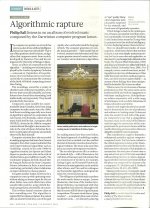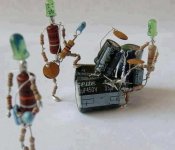Yes. And it seems to me, nothing more left to damage. The progress has stopped.
Edit: except auto-compose, probably...
It's being pushed.
Attachments
Sadly, I've had to drastically curtail my mosh pit activities of late.All you have to do is watch this and nothing more has to be said. Scroll about 1 minute in.
Funny how we put all musicians, music genre's and expectations all in one category. It usually takes one or a few people to start something new and then it becomes the newest and greatest thing. But for the true musician or composer I would say that you just can't pigeon hole everyone. While many of us do appreciate and love a great jazz musician and their craft it is funny that they are usually the least financially sound in the industry, jazz musicians usually die poor and broke. Nobody is willing to pay the same price to see a great musician as they are to see some old wrinkly Madonna or Cher concert that is just the pits. If we are all going to think that there is nothing new in music or even in the way to improve the way it is reproduced then why continue with all these conversations here and just take our balls and go home? I for one do not think that this is the end, perhaps we are just in a period of in-between before something new happens? Are opamp based power chips the end or discrete amplifier design and we have reached the end, I highly doubt that.... There is much to much intelligence here in this one thread to say that people have hit the end of the road, there is always the few that will drag the rest kicking and screaming into the future and change how we think. I for one am not ready to roll over and just call it quits, time to double down and take a leap of faith and create something new. First we have to kill MP3, at least in its lossy format and perhaps we can get back to the music.
Steven
Steven
The Ukulele Orchestra of Great Britain - Anarchy In The UK - YouTubeSadly, I've had to drastically curtail my mosh pit activities of late.
The optical system seems very close to this: Fiber Optic Measurement Systems: Non-contact Measurement Sensors, Solutions and Systems - MTI Instruments
Good read. Thanks.
Fig. 2 to Fig. 6 seems to apply to the operation mode of the Optoacoustics “Diamond” mic system (and the transmit-receive bundles are discrete).
It is the nature of the application that allows the use of Multi-mode optical fiber - Wikipedia, the free encyclopedia as the means for distant interconnect.
Bundle itself and end connectors are much cheaper and less delicate than of the single mode, but nevertheless much more expensive than an expensive electrical cable and much more prone to damage.
This “fragility” and high cost of replacement is the big problem that users will face in non permanent installations.
A foot stepping on a bundle or normal coiling-uncoiling of the “cable”, wear out the cladding of the fibers.
Small radius bending and impact from an edgy object, brakes fibers.
All these happen more often than one can think. (*)
George
(*) The so called “liquid cables” don’t have glass fibers to brake or cladding to wear out but a transparent liquid or gel inside. They are much more durable (and more expensive) but they can not pass through light amplitude variations above the subsonic range or low bass at best. They function as LP filters, for now at least.
On the other hand, I have a new 19 year old technician, who I met up with at the latest AES Convention (where were the rest of you?). He showed me how he creates electronic compositions on the latest electronic processors. It was AMAZING! This guy could pound on something that looked like an elaborate drum pad and make music! He is good at it too. When I was young, and 'Tutti Frutti' was one of my theme songs, MY parents were sure that Western Civilization was lost and that was more than 55 years ago. '-) Keep an open mind, guys. There are always 'punks' who want to annoy and disgust the 'squares', they have always been, and they still are.
Last edited:
ABSOLUTE response calibration without a transfer standard. I hope to get this into Linear Audio as soon as I get time to sit down with our B&K reference equipment to verify this.
Check your calibration’s uncertainty budget before
Me too, peeling back the specs they seemed quite mundane. Big issue, the best optical position sensing techniques present an almost insurmountable fringe counting issue unless you restrict motion to < 1 wavelength then the SNR is very bad.
I would try a force balance system using the optical path to 0 the diaphragm position.
This are all spot on (*). One can not escape physics limits.
Once one starts scrutinizing the high tech new staff the way and to the extend that the established technology has gone through, things will settle down a bit.
The only path that has merit for the MEMS mics (for serious audio) is through the adoption of lessons learned and practices implemented in ultrasonic phase arrays (electronic focusing, steering and other multi sensor element signal spatial effects manipulation).
(*)But Optonics mic does not rely on fringes
George
Actually from the 80's on the only really new thing in music is computer based music. Within it's own world it is amazing. But, since anyone can turn on a device and start making music, now that encourages laziness with regard to formal music training. From what I understand similar attitudes were expressed when recorded music came about. So it goes, I feel old.
Last edited:
And here, we can correlate those two subjects.
Once the perfect 1$ 1-40 000hz flat phase light mike will be there, all recordings will sound the same ?
It is already much cheaper and easier to produce massive amount of bad records than 40 years ago.
I don't worry, here, we all have our soldering iron in a very accessible place. Don't we ?Keep an open mind, guys.
Actually from the 80's on the only really new thing in music is computer based music. Within it's own world it is amazing. But, since anyone can turn on a device and start making music, now that encourages laziness with regard to formal music training. From what I understand similar attitudes were expressed when recorded music came about. So it goes, I feel old.
Add here computer simulation of equipment that produces the music, and we are in the copy-paste society. Simulation of simulators that were designed by those who simulated designs of people who knew what they were designing.
Damn! This patent is exactly what I've described .
Good. Mind the formula on page 6
Kgrlee
You know much about mikes.
You’ve worked with them.
You love the subject .
Look in the new patents. There are 10-20 unique ideas, different from each other.
I trust you will come to envision something that will satisfy you.

George
Attachments
… I have a new 19 year old technician …
…
Hi John,
Should you ever need a New-Old 69 years old technician, please let me know and I'll come over…
All you have to do is watch this and nothing more has to be said. Scroll about 1 minute in.
Fun movie, my favorite observation on the state of music is here. Unfortunately I can't find the version with the pictures, RIP Claude Bessy.
Claude Bessy aka Kickboy - YouTube
Western Civilization was lost and that was more than 55 years ago. '-) Keep an open mind, guys. There are always 'punks' who want to annoy and disgust the 'squares', they have always been, and they still are.
You can read it for free now The decline of the West
"Rubbing the squares the wrong way" Byron Coley circa 1982
Oops BradOn the decline of music: I think it began with the almost universal adoption of equal temperament, and a consequent dumbing-down of most of our pitch discrimination. The end results of the process are manifesting as things like auto-tune
auto-tune and equal temperament in the same coffin?
The time of (preexisting) equal temperament adoption, that is early to mid baroque period, was the time that some different musical instruments had already began to form trios, quartets ect.
Considering the dissonances within a particular tuning method of each such instrument (and there were many for each kind of instrument), you can see that it was a real necessity for the adoption of eq. Temp.
There was not even an agreed tuning pitch then.
Small Cembalo became bigger, went to five “octaves”, proper tuning was almost impossible , wolf tones were inevitable.
Equal temperament tuning was not born out of laziness or incapability of the musicians or the indifference of the audience as is the case with auto-tune today.
The excellent book of Herman Helmholz “On the sensations of tone as a physiological basis for the theory of music” in the English “translation” (a book within a book actually) of Alexander Ellis has everything one can hope to read on this (ample historical and “technical” documentation).
Old Colony Sound (yes) has reprinted this thesaurus of knowledge ~10-15 years ago. This is to their credit.
One can have it as pdf here http://archive.org/download/onsensationsofto00helmrich/onsensationsofto00helmrich.pdf
But it is not a book to be read through a screen.
The 12 Equal temperament tuning adoption may have made some form of “globalization” effect (impact) on music worldwide but consider composing, instrumenting and performing a score for 10 or 20 instruments without it.
Pitch discrimination capabilities degradation? “Perfect pitch” laid aside, all western musicians 200 years now would have their capability degraded. Yes?
No.
My poor pitch discrimination capability has degraded because I don’t attend live performances with non electrical instruments and because I listen to synthesized and intentionally distorted electrical musical instruments (which I enjoy nevertheless
George
Last edited:
Strongly recommended reading: Ross W. Duffin, "How Equal Temperament Ruined Harmony (and why you should care)". ISBN 0393062279.
The ironic thing about auto-tune is that, in principle, it could be an aid to "just" intonational music. Of course today it's used to allow mediocre singers to hide behind their shortcomings and pass off the result as a stylistic device (IMAO).
The ironic thing about auto-tune is that, in principle, it could be an aid to "just" intonational music. Of course today it's used to allow mediocre singers to hide behind their shortcomings and pass off the result as a stylistic device (IMAO).
The ironic thing about auto-tune is that, in principle, it could be an aid to "just" intonational music. Of course today it's used to allow mediocre singers to hide behind their shortcomings and pass off the result as a stylistic device (IMAO).
Right. They sound like robots. I suppose, for robot's taste. Quite annoying, more annoying may be a tooth drill machine only sounds.
Duffin quotes Helmholtz (George's op. cit.) thus: "If an instrument of fixed tones is completely and uniformly tuned according to the equal temperament, so that all Semitones throughout the scale have precisly the same magnitude, and if also the musical quality of all the tones is precisely the same, there seems to be no ground for understanding how each different key should have a different character."
This is not stated approvingly, although Hermann is not around to ask exactly how he felt.
This is not stated approvingly, although Hermann is not around to ask exactly how he felt.
- Status
- Not open for further replies.
- Home
- Member Areas
- The Lounge
- John Curl's Blowtorch preamplifier part II

